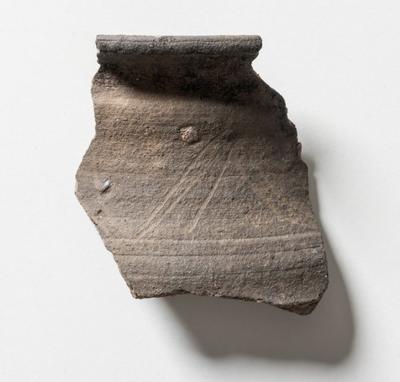Vessel, pottery fragment, rim sherd
Object detail
Description
Fragment of Roman grey pottery. Rim and shoulder fragment, from a small to medium open mouthed vessel, most likely a jar or a beaker. Greyish-brown paste, light and hard with course texture and flaky fracture. The surface is a darker grey, with sparse (quartz?) inclusions. The piece is wheel made, with a number of regular striations across the exterior surface. Directly under the lip are a the remains of what appears to be black or brown slip or possibly traces of burning. A crude shallow triangular/chevron design is scratched into the interior surface, just above the shoulder. The surface appears to have been burnished, although wear and erosion make it difficult to be certain. The lateral section is complex, with a shallow shoulder curving up towards a rounded cordon, then a stronger curve outward to an almost horizontal lip.
Classification
ARCHAEOLOGY Roman
Measurements
H70mm x W64mm x D15mm
Media/Materials description
Pottery vessel made of fired clay, complete or fragmented
Inclusions (quartz) to make the clay less sticky, reduce shrinkage, increase resistance to thermal shock and strength prior to firing.
Inclusions (quartz) to make the clay less sticky, reduce shrinkage, increase resistance to thermal shock and strength prior to firing.
Signature/Marks
J.41
History and use
This is a sherd of pottery from a Roman period vessel. Pottery sherds are broken pieces of pottery, often with irregularly shaped broken edges. How do we know what part of a vessel a sherd came from? Sherds can be classified into one of three categories: rim sherds, body sherds, and base sherds. Rim sherds are the most informative and easy to classify and tell us what kind of rim a vessel had: inslanting, flared or vertical. The curvature of the rim can be measured to tell us the size of the vessels opening.
Associated person
Registration number
E40014



